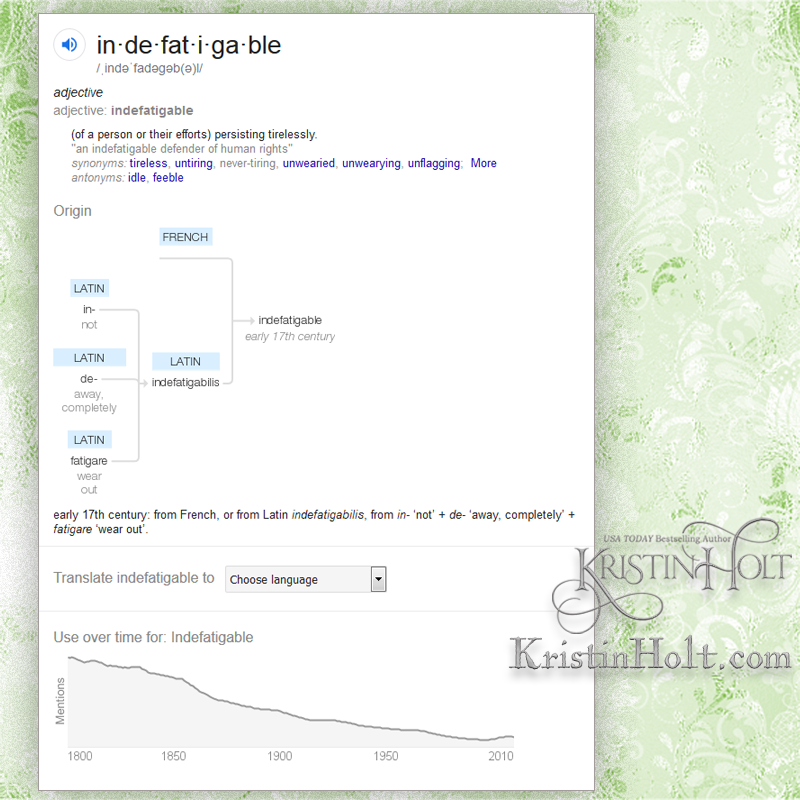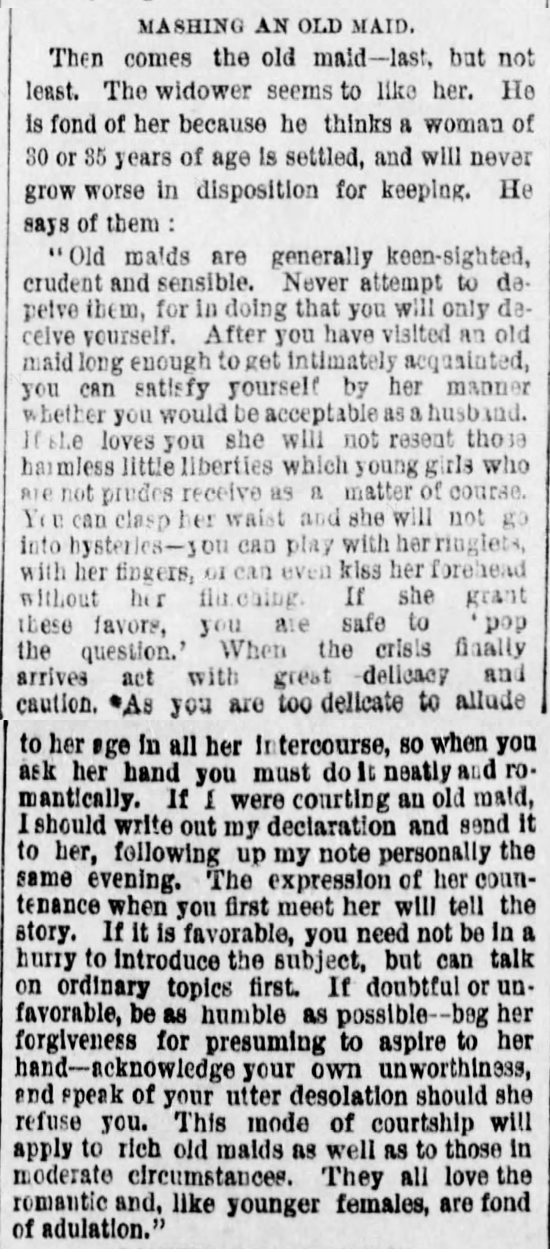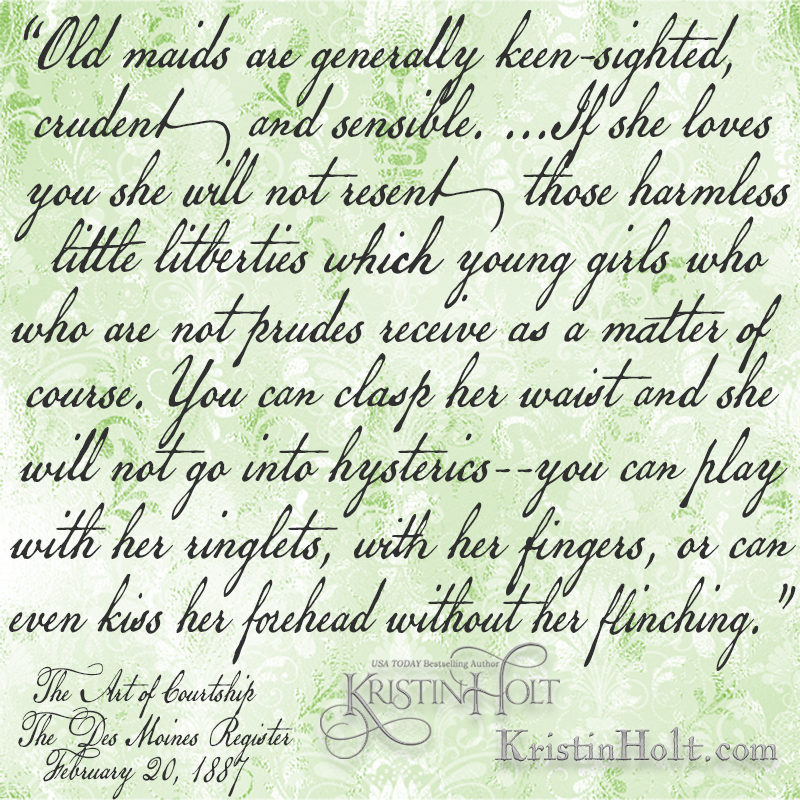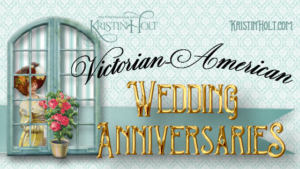The Art of Courtship
.
Victorian-era courtship customs and etiquette make for fascinating reading, especially for those of us who enjoy reading (and writing) American Historical Romance. Discovery of this 19th century newspaper article prompted me to share with other historically curious minds. The Art of Courtship. Carries a lovely ring, doesn’t it?
Courtship, far more an art than a science, confounds marriage-minded young men. Thank goodness for vintage wisdom from a thrice-wed and thrice-widowed gentleman in ~
.
The Art of Courtship: Rules for Making Love to Heiresses, Coquettes, Widows and Old Maids
~ The Manner in Which Girls Were Wooed and Won Thirty Years Ago — Some Suggestions to Ladies Also — Popping the Question.
.
Published in The Des Moines Register of Des Moines, Iowa on February 20, 1887, the full article is informative and fun!
.

.
Origins, and a Vintage Lens
An important detail to keep in mind is the “thirty-years-ago” viewpoint of the 1887 newspaper columnist. Traditions, expectations, standards, etc. presented in this article represent mid-nineteenth century courtship. Apparently an unnamed St. Louis Globe-Democrat reporter found a booklet in a bookstore, published by Dick & Fitzgerald “thirty years” previous (circa 1857). According to the author, significant changes in courtship occurred in the intervening years.
The Globe-Democrat reporter might die of apoplexy if he witnessed all that passes for courtship today.
.

Define: Apoplexy, courtesy of google
.

The Art of Courtship, Introduction, from The Des Moines Register of Des Moines, IA on February 20, 1887.
.

The Art of Courtship, quote from within: “The first requisites laid down for a successful courtship are confidence and self-esteem.” From The Des Moines Register of Des Moines, IA on Feb. 20, 1887.
.
Did you notice? “Do not marry young fellows who have sown their wild oats…” An interesting bit of advice, particularly as he provides no explanation.
Why do you suppose our Thrice-Widower made a point to advise girls of such? Can you imagine the parlor talk that day? “Tell me, Mr. Thomas, have you sown wild oats?”
.

.
Choosing a Wife
.

The Art of Courtship, Part 2: Choosing a Wife, from The Des Moines Register of Des Moines, IA on February 20, 1887.
.

Quote from within The Art of Courtship: “When it shall please god to bring thee to man’s estate, use great providence and circumspection in choosing thy wife…” by Cecil, Lord Burleigh
.
.

.
Beginning a Courtship
.

The Art of Courtship, a quote from within Part 3: Beginning a Courtship, from The Des Moines Register (1887). “She may be a wayward coquette, a domestic young lady, a prude, a proud strip of a thing, an actress, a blue stocking, a widow, or worse than all the others combined, an old maid. The triple widower tells how to tackle them all. He seems to have an experience with everything in petticoats.”
.

The Art of Courtship, Part 3: Beginning a Courtship, from The Des Moines Register of Des Moines, IA on February 20, 1887.
.
Did you notice the import given to seeking permission (acceptance?) from the girl’s parents? This formal step in the nineteenth century courtship process served purposes far greater than merely good manners or etiquette. Every young man sought a warm reception when accepting an invitation from his best girl. Without parental approval, the pining swain wouldn’t likely find many invitations to call coming his way.
Are you surprised that our young would-be suitor is forced to wait for an invitation to call? It’s true!
.

.
If the Girl is Shy
.

The Art of Courtship, Part 4: If the Girl is Shy, from The Des Moines Register of Des Moines, IA on February 20, 1887.
.

.
Courting a Coquette
.

Define: Coquette, courtesy of google
.

The Art of Courtship, Part 5: Courting a Coquette, from The Des Moines Register of Des Moines, IA on February 20, 1887.
.

.
Shinning Up to Miss Bashful
Shinning? What on earth is shinning? I do recognize shining (as in “the shining sun warmed my back”) and I know what a shin is. I have two, one on each lower extremity. (Victorian ladies and males in their company would never call a lower limb anything more … accurate.)
.

Define: Shinning (or Shin), courtesy of google
.

Define: Diffident, courtesy of google
.

The Art of Courtship, Part 6: Shinning Up to Miss Bashful, from The Des Moines Register of Des Moines, IA on February 20, 1887.
.

.
Catching an Heiress
.

The Art of Courtship, Part 7: Catching an Heiress, from The Des Moines Register of Des Moines, IA on February 20, 1887.
.

.
Courting a Literary Lady
.

Define: Bluestocking, courtesy of google
.

.

The Art of Courtship, Part 8: Courting a Literary Lady, from The Des Moines Register of Des Moines, IA on February 20, 1887.
.
Indefatigable? That one deserves (and desperately needs) a look-up. At least for me.
Note the sharp decline in use from “very high” circa 1800 to “low” (erudite, anyone?) use at 2010.
.

Define: Indefatigable, courtesy of google
.

.
Beware of “Vidders” (Widows)
Quoting from the Beware of Vidders section, the widower is not very flattering in his opinion of the widow. He says: “Considering all the peculiarities, the courtship of a widow if a mere formal matter of business. Any man with sufficient nerve to use his own judgement in the purchase of a horse may churt a widow without trouble, and without advice.”
Churt a widow?
We could have a bit too much fun with this one. Believe you me, I looked this one up. Everywhere. In modern dictionaries as well as old-time tomes. My best guess is as good as yours. If you can find a definition, or know a great resource, please let me know. I’ll thank you for it!
Given context, I’ll take the first guess:
Replacing “churt” with a modern, easy-to-comprehend word, from the vintage sentence:
“Any man with sufficient nerve to use his own judgement in the purchase of a horse may churt ________ a widow without trouble, and without advice.”
- choose
- court
- select
- win
- ?
.
Read on to see why widows are both the most appealing possibilities… unless you’re another unattached young lady.
.
![Kristin Holt | The Art of Courtship, Part 9: Beware of "Vidders" [widows], from The Des Moines Register of Des Moines, IA on February 20, 1887. Kristin Holt | The Art of Courtship, Part 9: Beware of "Vidders" [widows], from The Des Moines Register of Des Moines, IA on February 20, 1887.](https://www.kristinholt.com/wp-content/uploads/2019/06/Newspaper-The-Art-of-Courtship.-Part-8-Vidders.png)
The Art of Courtship, Part 9: Beware of “Vidders” [widows] [widows], from The Des Moines Register of Des Moines, IA on February 20, 1887.
This magical phrase is definitely worth repeating. Note, above, the last half of the first paragraph, immediately following the three spaced asterisks: * * *
.
.
In making love to a widow you have nothing to do but to answer her questions, and return her caresses. She will remind you when the time has come to ‘pop the question.’ You will get better acquainted with a widow in three visits than you would with an ordinary young girl in as many months. Some rhyming wag says:
.
To court a blushing maid, you wheedle, coax and flatter–
In wooing a widow, what you do’s no matter!.
As a general thing, a pretty young widow can have her choice of a husband among all the gentlemen of her acquaintance. Marriageable girls, unless their market is made, do not like to see young widows around.”
.~ The Art of Courtship, Part 9: Beware of “Vidders”, last 1.5 paragraphs
.

.
Mashing an Old Maid
Mashing?
I understand mashing potatoes. And can relate to “squashing” a rebellion, or a child’s creative spirit. But “Mashing an Old Maid”?
This one really required a look-up.
.

Define: Mashing (or Mash), courtesy of google
.

The Art of Courtship, Part 10: Mashing an Old Maid, from The Des Moines Register of Des Moines, IA on February 20, 1887.
.

Quote regarding Old Maids and liberties they allow, from The Art of Courtship, Des Moines Register, February 20, 1887. “Old maids are generally keen-sighted, crudent and sensible. …If she loves you she will not resent those harmless little liberties which young girls who are not prudes receive as a matter of course. You can clasp her waist and she will not go into hysterics–you can play with her ringlets, with her fingers, or can even kiss her forehead without her flinching.”
.

.
Popping the Question
.

The Art of Courtship, Part 11: Popping the Question, from The Des Moines Register of Des Moines, IA on February 20, 1887.
.

.
Making a Beau Propose
.

The Art of Courtship, quote from within: “Here, girls, is what you must do to induce him to propose:.” From The Des Moines Register of Des Moines, IA on Feb. 20, 1887.
.

The Art of Courtship, Part 12: Making a Beau Propose, from The Des Moines Register of Des Moines, IA on February 20, 1887.
.

.
Surrounding a Bachelor
.

The Art of Courtship, Part 13: Surrounding a Bachelor, from The Des Moines Register of Des Moines, IA on February 20, 1887.
.

.
Conclusion
.
This columnist’s conclusion is worth emphasizing, I believe. Note his emphatic statement that such courting behavior isn’t present in his neck of the woods, and he doubts the remotest corners of the earth harbor them either.
.
They were sweetly simple and innocent arts, just like the simple, honest, innocent, slow-going folks for whom they were written. At the present time they are literary and psychic curiosities.”
.
~ The Art of Courtship, conclusion. The Des Moines Register of Des Moines, IA on February 20, 1887.
.

The Art of Courtship, Part 14: Conclusion, from The Des Moines Register of Des Moines, IA on February 20, 1887.
.

.
Related Articles
.

.
Copyright © 2019 Kristin Holt LC























